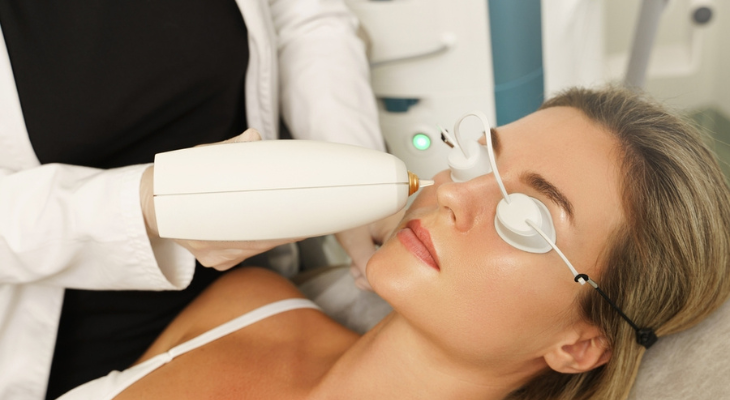
The Benefits of Light Therapy for Dry Eye Disease
Dry eyes aren't just an annoyance. The disease can blur your vision or even damage your eyes in severe cases. If lubricating drops or artificial tears don't keep your eyes moist enough, your vision therapist may recommend light therapy, an innovative treatment that offers real relief of dry eye symptoms.
The Problem with Dry Eye Disease
Dry eye disease can affect anyone at any time, although it's more likely to happen as you get older. Dry eye symptoms may occur if you don't make enough tears or the tears your body makes evaporate too soon or don't spread over the entire eye in an even layer.
Dry eye causes a variety of symptoms, including:
- Red, Irritated, Itchy Eyes
- Stringy Mucus
- Light Sensitivity
- Blurry Vision
- Stinging or Burning Pain
- A Feeling That Something Is Stuck in Your Eye
Interestingly, watery eyes can also be a symptom of dry eye. The problem occurs when your eyes overcompensate for the dryness by producing too many tears. Severe dry eye can cause scratches or sores on your cornea, which could interfere with your vision or cause vision loss. The cornea is the clear tissue covering your iris and pupil.
You may be more likely to develop dry eye disease if you're female, wear contact lenses, or take medications that decrease tear production, like antidepressants, blood pressure drugs, antihistamines, and decongestants. The American Optometric Association (AOA) notes that people who wear contact lenses or had refractive eye surgery to sharpen vision may also develop dry eye.
Other risk factors include spending time in windy or smoky environments and using digital screens without taking frequent breaks. People who have certain diseases, like diabetes, thyroid disease, rheumatoid arthritis, or blepharitis, may be at increased risk for dry eye, according to the AOA.
How Light Therapy Can Help Your Dry Eye Symptoms
Intense pulsed light (IPL) treatments, a type of light therapy, can help if dry eye is due to an issue with your meibomian glands. The glands, located on your eyelid around your eyelashes, produce a type of oil called meibum. The oil makes up the top layer of tears and stops the tears from evaporating too quickly.
Your eyes will feel dry if the meibomian glands don't make enough oil or become clogged. Fortunately, IPL treatment offers an effective way to unclog these glands. During treatment, your doctor uses a handheld device to deliver short bursts of light to your eyes.
IPL therapy eases dry eye symptoms by:
- Unclogging Meibomian Glands. The warmth from the light pulses warms the glands, which dissolves clogs. After using the IPL device, your vision therapist will softly massage the glands to force out (express) the meibum. In a Mayo Clinic research study, 58% of patients who received IPL therapy and meibomian gland expression saw a 25% to 50% improvement in dry eye symptoms.
- Killing Bacteria and Mites. IPL treatment kills microscopic mites and germs in the glands that could cause inflammation, irritation, and infections.
- Reducing Redness. Light therapy also shrinks blood vessels and can be particularly helpful if dry eyes are related to rosacea or blepharitis.
- Improving Gland Function. IPL therapy helps the meibomian glands work better, reducing your risk for dry eye disease symptoms in the future.
- Decreasing Salt Content. You may be more likely to have dry eye disease if your tears are high in salt. IPL lowers the salt content of your tears, improving your symptoms. In a study published in the Journal of Clinical Medicine, patients experienced significant changes in salt content after four sessions of IPL therapy.
Anesthetic cream, cooling gel, and eye shields protect your eyes from the bright lights during IPL treatments, which only takes about 15 minutes. You can return to your normal activities immediately after your treatments. You'll return to the vision therapy office for light therapy every month for three or four months. After that, you may only need treatments once or twice per year.
Are you feeling frustrated by your dry eye symptoms? IPL may offer the ideal solution. Contact our office to schedule an appointment with the vision therapist.
Sources:
American Optometric Association: Dry Eye
https://www.aoa.org/healthy-eyes/eye-and-vision-conditions/dry-eye?sso=y
Mayo Clinic: Intense Pulsed Light for Treatment of Dry Eye Disease, 7/16/2016
NCBI: Journal of Clinical Medicine: Characterization and Prediction of the Clinical Outcome of Intense Pulsed Light-Based Treatment in Dry Eye Associated to Meibomian Gland Dysfunction, 8/13/2021
https://www.ncbi.nlm.nih.gov/pmc/articles/PMC8396809/
Medical News Today: How Can Light Therapy Help Dry Eyes?, 5/31/2022
https://www.medicalnewstoday.com/articles/light-therapy-for-dry-eyes
Nature: Effect of Low-Level Light Therapy in Patients with Dry Eye: a Prospective, Randomized, Observer-Masked Trial, 3/4/2022
https://www.nature.com/articles/s41598-022-07427-6
Ophthalmology Times: Understanding Role of IPL in Dry Eye Disease, 9/24/2019
https://www.ophthalmologytimes.com/view/understand-expanding-role-ipl-dry-eye-disease

